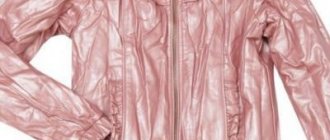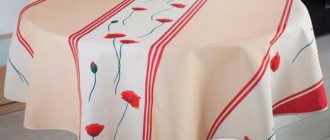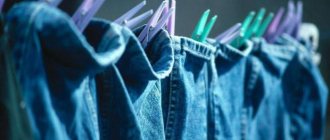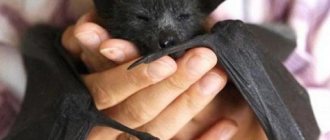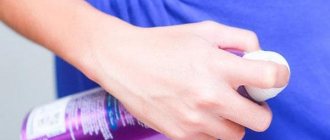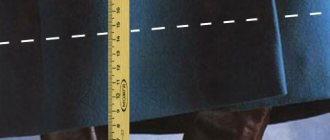To decorate the kitchen table, housewives are increasingly using products made from oilcloth, Teflon, vinyl, PVC and non-woven material. They look attractive, are easy to clean from dirt, and do not lose their properties for a long time, but sometimes it becomes necessary to smooth out a surface covered with creases. And this is where the problems begin, because you can’t get rid of aesthetic defects in the traditional way. But there are still approaches with which you can quickly restore the smoothness of the material.
Is it possible to iron a tablecloth with an iron?
You cannot iron oilcloth in the traditional way at normal temperatures. It is easy to get rid of creases - you will have to iron it in the most gentle mode with the lowest possible heating temperature. The iron should be warm, but not hot.
The procedure is as follows:
- First, a cotton piece of fabric is placed on the oilcloth surface. To be sure, lightly moisten the rag with water and wring it out well.
- Set the iron to the most gentle of the built-in modes.
- The work is carried out from the wrong side of the canvas. It quickly loses its original shade if you move along the front side.
- Pass over the tablecloth several times. The manufacturer does not recommend staying in one place for more than one second. You shouldn’t use force or put pressure on the iron - it’s easy to ruin the coating.
- After smoothing, the canvas is allowed to cool slightly.
Ironing is dangerous for thin oilcloth fabrics. It's best to store them in a way that will prevent jams.
Vinyl
This is a very practical and easy-to-use material, prevents slipping on the table and protects furniture from damage, and at the same time looks very aesthetically pleasing. There are models of oilcloths that imitate fabric. They do not need to be washed, they do not wrinkle when crumpled for a short time, but if there are large folds, then it will be enough to smooth them out with a warm iron through a damp kitchen napkin.
We recommend: Basic rules and important points when choosing toothpaste
Please note that vinyl is sensitive to high temperatures, so before ironing, it is recommended to try it on an inconspicuous corner so as not to spoil everything. There is no need to press hard and stay at one point for a long time; just walk lightly, if necessary, several times.
Is it possible to smooth out wrinkled oilcloth with steam?
Another way to get rid of aesthetic defects on a disposable tablecloth is long exposure to steam.
- Method one. The covering is kept over a pan of hot water. But boiling water will not work; it is too harmful for thin materials. The water should be around 50°C. Exposure to steam will cause the oilcloth to become damp. It is hung in a vertical position on clothespins, with medium-heavy weights attached to the lower edge.
- Method two. After exposure to steam from a container of heated water, the tablecloth is placed on a horizontal surface. Flat, heavy objects are placed in place of the creases. A stack of books, magazines, or a heavy box will do. After 2-3 hours, the wrinkles will smooth out.
The same methods can be carried out by replacing the steam pan with a steamer. After processing the oilcloth in a suspended position, leave it to dry or spread it on a smooth table.
Polyester
The most common oilcloth in the kitchen, because it washes well, does not fade, does not wrinkle, and is inexpensive. There is pure polyester, and there is a cotton base. The first option is strictly forbidden to boil; it melts quickly and is afraid of fire. The second burns out in twice as long and also does not tolerate boiling. Therefore, temperature smoothing methods are used with great caution.
We recommend: 5 ways to remove a splinter from your skin
When wetting and drying for smoothing, it is necessary to avoid direct sunlight, they can only damage the product. But in general the method is very suitable for this material.
How to Level a Vinyl Tablecloth
Vinyl oilcloth looks stylish and successfully imitates fabric. When using it, it is difficult to wrinkle, but before the first use the material is usually wrinkled. To smooth it, use an iron and a cotton cloth soaked in water.
Vinyl coating does not withstand strong heat; you should not use the iron at maximum power or stay in one place for a long time. This may ruin the canvas.
By moistening the coating with warm water, get rid of creases and wrinkled places. Water is drawn into a spacious basin or bathtub and a tablecloth is lowered into it. The wet oilcloth is hung in a vertical position and waited until it dries.
Teflon
Teflon impregnation, like acrylic, is resistant to dirt and stains and has a water-repellent effect. But it does not like high temperatures, it cannot be washed, twisted or ironed, in which case Teflon releases harmful substances. If ironing such a thing is unavoidable, overheating must be avoided. The tablecloth can be washed at a temperature not exceeding 40 degrees Celsius, and ironed with a warm iron.
The method of pulling out folds while wet is not very suitable, but it can be used.
Polyethylene tablecloth
A regular hairdryer will help get rid of creases on a transparent PVC sheet. This will take a long time, but the result is excellent:
- The material is laid out on a smooth, spacious surface.
- A simple hair dryer is set to medium power if there is a regulator. The air must be warm; cold air will have no effect.
- Holding the device at a distance of about 30 cm from the surface of the tablecloth, direct heat to the wrinkled areas.
- After a few minutes, the bumps will begin to disappear.
Do not use a hair dryer closer than the specified distance; do not set the maximum air flow on the device. These actions will lead to damage to the tablecloth.
The hairdryer method is suitable for thin coatings. The large thickness of the material will force the housewife to stand over it for a long time with a hairdryer.
How to straighten a raincoat?
Using a steamer (steam generator) or an iron with a vertical steam supply function (steam boost). At home, the raincoat can be hung on hangers or ironed horizontally. The fabric is not ironed; a lot of steam is simply applied to it.
Interesting materials:
How to receive a Ukrposhta transfer? How to receive a Golden Crown transfer in Belarus? How to get peach color for wall painting? How to get characters in Genshin Impact? How to get the first category as a doctor? How to get your first subscribers on YouTube? How to get a five star hero in Empires and Puzzles? How to get Pikachu at the very beginning of the game? How to get Google AdSense PIN code? How to get a Google Adsense PIN code?
Silicone tablecloth
Before use, the silicone material must be “glued” to the surface of the table, it will smooth out on its own. Apply water from a spray bottle to the cover and to the table, and carefully spread the tablecloth. Silicone does not slip on the surface of the tabletop; just lay it flat and press it with your palms. Remains of water are removed with a dry cloth.
This type of fabric can also be ironed with an iron at minimum heat, spraying water first. Small thickness - use a hair dryer.
The method with hanging and weights is not suitable; the material can be deformed irrevocably. It is also impossible to straighten the canvas with steam, as it risks stretching.
Polyvinyl chloride
PVC material is popular due to its long service life and practicality. Does not require ironing, but if such a need arises, use an iron and a damp cloth. Minimum temperature is required, all irregularities are removed with light, smooth movements. Using a hair dryer is acceptable, even more convenient, if the thickness is small.
Advice
PVC products can only be washed at water temperatures up to 40 degrees Celsius - and only by hand.
How to iron a paper tablecloth
The most effective way to get rid of unevenness on a paper coating is to iron it with an iron. You will need to lay a dry cotton napkin on top so that the paper does not get too hot. If the heat is too high, there is a risk that the tablecloth will turn yellow. The appliance must be set to the medium temperature range.
Flattening paper under a press is a time-consuming method of removing folds and creases. The tablecloth should remain under a massive flat load for three to five days. The risk of paper damage is reduced.
The paper covering must not be wetted. It is important to avoid humidity; the canvas may lose its shade intensity, and the paints run the risk of running and smearing.
The canvas must be stored carefully. If you wrap the material in a roll, like wallpaper, it will not wrinkle.
Acrylic
This is a wear-resistant and waterproof material based on cotton or linen, but, unlike natural woven fabrics, it does not wrinkle and is not afraid of stains, while maintaining the structure and properties of ordinary fabric, creating a spectacular look on the table. Acrylic impregnation is resistant to high temperatures and can withstand a hot pot or frying pan. It can be washed and ironed on the reverse side at normal temperatures. There is no need to use other methods here.
There is only one drawback - over time, acrylic loses its properties.
Methods for smoothing out wrinkled paper
- Using the press;
- Straightening paper using an iron;
- Straightening using a printer;
- Other methods.
Let's take a closer look at the three main methods in the office and at home.
Using the press
- If the paper is wrinkled, you can straighten it using a press. Using a press is a more gentle method that is suitable even for straightening important documents, watercolor works and rolled paper, but will require more time.
- First, you need to hold the crumpled sheet against the edge of the table, carefully pulling it in order to level the sheet as much as possible.
- Then place the sheet face down on a clean surface, then moisten it with filtered water from a spray bottle and distribute the moisture over the surface with a sponge.
- For denser specimens, it is necessary to moisten with water several times after a short amount of time.
- The crumpled paper should be covered with a dry and clean cotton cloth. These can be scarves, baby diapers that absorb moisture well. The more often you change the wet cloth for a dry one, the faster the sheet will dry.
- Heavy objects are suitable as a press, for example, large books in combination with furniture boards or thick cardboard. The larger the paper size, the larger the board required. On the prepared sheet, covered with a cloth, you need to place a board with a stack of weighty books or other weight.
- The time spent under the press depends on the density of the sheet and its humidity. Sometimes it is enough to leave it for a few hours or overnight. The densest and wettest specimens take up to four days to dry. The process will go faster in a dry, ventilated area. To reduce indoor humidity, use air conditioning in dehumidifying mode, fans and heaters.
- You can also put a dry, crumpled page under a press for a long time. In this case, it will straighten out, but perhaps traces of fractures will remain.
Oilcloth on the table
Oilcloth is a wonderful invention of our time, which allows you to protect the surface of the kitchen or dining table from scratches and damage.
It covers the table, allowing you to change the design of your kitchen every time and helping it look fashionable and modern. Using oilcloth on the kitchen table has a direct practical purpose, because during breakfast, lunch or dinner the table gets very dirty. Therefore, to preserve the surface of the kitchen table from dirt and damage, oilcloth plays a very important role.
Textile tablecloths look very beautiful and harmonious in the interior of a kitchen or dining room, but they are quite impractical because they quickly get dirty and need to be constantly looked after: washed, ironed and starched. Oilcloth is convenient to use, easy to wash and clean from dirt.
How to wipe the green stuff off the table
To prevent a green stain from remaining with you for life, the first thing you should do is find out what your table is made of. Depending on the base material, the methods for cleaning the stain will differ.
Plastic
In general, it is believed that a plastic table is not a luxury item and will endure anything. However, it is not difficult to wash off traces of green paint from such furniture only at first glance. What should be done?
- Any liquid product that contains chlorine will help to wash brilliant green from a white table;
- for other shades - gasoline, a solution of washing powder or soap, kerosene, alcohol-based wet wipes.
Tree
Wood is the most capricious material, therefore the methods for cleaning stains from green paint in this case should be very delicate and soft:
- Immediately cover the stain with soda or salt and leave for a while until the product absorbs all the moisture from the antiseptic. If you only use baking soda, pour a small amount of vinegar onto it. As you know, a reaction will occur immediately. As soon as the mixture stops sizzling, remove it with a soft, damp cloth.
- Soak a cotton pad in alcohol and wipe the stain until it disappears. The disk must be changed each time it gets dirty. In this case, alcohol can be replaced with vodka or lemon juice.
- An excellent product for removing greenery from the table is Amway Home, but not every home has it. If you have any left over, use it immediately by applying it to a soft sponge and gently wiping the contaminated area.
If none of the methods help, then there is only one way out - grinding the surface. This is the only way you can say goodbye to the green stuff on the table by removing the layer where it has become firmly embedded.
Removing stains from a tablecloth
The tablecloth on the dining table seems designed to attract stains and act as a splash catcher. Always check the tablecloth for stains before washing. Some of them may not be visible, but they can provide food for insects and a breeding ground for mold.
If your white tablecloth has yellowed or darkened, or if your colored tablecloth has lost its color, then take our advice before ironing the product and storing it.
- Prepare a solution of warm water and oxygen bleach.
- Immerse the product in the prepared solution and leave it soaked overnight.
- After this, wash the tablecloth as usual.
This method of updating a tablecloth is safe for products made from cotton, linen and synthetic fibers. Oxygen bleach can also be safely used on tablecloths that have been hand-painted, as long as the dye has been used correctly.
You can also use blue when washing or rinsing a white tablecloth to make it incredibly white and look like you just bought it. You just need to carefully follow the instructions that manufacturers indicate on products of this kind.
Ironing round or oval tablecloths
Step 1
Imagine a round or oval tablecloth shaped like a pizza.
Step 2
Carefully lay the tablecloth across the ironing board and press down on the center of the tablecloth.
Step 3
Working outward from the center, iron one “pizza slice” at a time, working from the center to the edge.
Step 4
Turn the fabric and move to the next section. Repeat until all the fabric is ironed.
Features of caring for kitchen textiles with Teflon impregnation
One of the advantages of Teflon tablecloths is ease of care and preservation of appearance with frequent use. All this does not negate compliance with several rules for using such textiles.
1Rule one. It is better to eliminate the consequences of liquid spills immediately. As soon as you notice a stain on the tablecloth, use a soft napkin, paper or fabric, to gently blot up all the liquid. There will be no traces of liquid left, you will not get dried stains that will have to be soaked. 2Rule two. If you notice too late a spilled liquid or food residues that have dried out, do not use abrasives or aggressive detergents that can damage the integrity of the Teflon layer. It is enough to moisten the stain with warm water, wipe off any remaining food or liquid with a cloth or microfiber cloth, wipe the tablecloth with a clean damp cloth, then with a dry cloth. 3Rule three. Try not to wash the tablecloth too often. After about six washes, the Teflon coating will begin to thin out, lose its integrity, the tablecloth will become more dirty, and it will be more difficult to wash it.
If you decide to wash a Teflon-coated tablecloth:
- It's better to do it manually. Using warm water no higher than 40 degrees C. Choose laundry soap, from powders - better for children's laundry, or a little dishwashing liquid. Rub the tablecloth carefully, try not to make creases on it, do not twist it.
- If you choose machine washing, set the gentle wash mode and turn off the spin cycle.
- The tablecloth should be dried flat and ironed with a lukewarm iron without steaming.
After washing, the tablecloth may shrink by several centimeters, even if the base fabric is not subject to shrinkage. Therefore, it is important to take this fact into account when buying a tablecloth; it is better to take the size of the product with some margin for possible changes in size. A tablecloth, the edges of which protrude less than 15-20 cm onto the edge of the tabletop, looks unpresentable.
If your tablecloth has lost its attractive appearance or has become so dirty that it has to be washed after each use, it is better to replace it with a new one. At the same time, a product that was used to serve a holiday or dinner table can be tried to be used at the dacha or for picnics, where the presence of small, unnoticeable stains is not critical. After all, even if the protective coating itself has partially lost its properties, the base fabric can remain of just as high quality.
Users who bought a Teflon-impregnated tablecloth give only positive reviews about their purchase. Here, for example, is what they write about this product on the Otzovik website.
Review 1
The Seven Teflon tablecloth cost me only 60 rubles. I bought it by pure chance; the store advertised it as a high-quality, affordable product for the kitchen. I decided to try it, because my oilcloth was already worn out, and a new one was more expensive than this tablecloth. I was surprised how wonderful this item is for the kitchen. My kids eat breakfast on the go and always spill or knock something over. I had to quickly wipe the table, but there were still a few stains on the tabletop. The new tablecloth does not let water and tea through, does not get dirty after spilled soup, and looks wonderful.
- Advantages: Large selection of colors, spilled food can be easily removed, fabric does not get dirty, you can place a hot dish.
- Disadvantages: I don’t find any, they simply don’t exist.
The size of 1.6 by 1.2 m turned out to be too big for my kitchen table, I had to bend the tablecloth a little. Otherwise, it's an excellent choice.
Review 2
The tablecloth was chosen to match the color of the wallpaper. They look very stylish to me. But that was the problem. Ordinary oilcloth looked too cheap next to it, and textile tablecloths got dirty too quickly and lost their attractive appearance. I decided to try a tablecloth with a Teflon coating. I read a lot of reviews from satisfied owners of the miracle tablecloth, and decided to go for it. Moreover, 65 rubles is not too much money. But it turned out that this tablecloth is even better than what was written about in the reviews. I managed to choose a color that was very close to the wallpaper pattern, fortunately there is a very large selection.
It is true that the tablecloth is very easy to care for and practically does not get dirty. I’m used to removing all the stains and crumbs from the table at once, without allowing them to dry out. Therefore, in six months I have never had to seriously clean the tablecloth; I just wipe it with a slightly damp cloth. This tablecloth makes my kitchen look festive and I really enjoy staying here longer. I noticed that I even began to cook with great pleasure. You can also place a hot plate on this tablecloth without using stands, it’s so convenient, especially with three children.
- Advantages: This tablecloth is one continuous advantage. Beautiful, festive, easy to care for, durable, and, on top of that, ridiculously cheap.
- Disadvantages: None and cannot be.
© 2022 textiletrend.ru
Folding round or oval tablecloths
Step 1
To fold a round or oval tablecloth for storage, fold it in half to create a semicircle.
Step 2
Fold the fabric in half again.
Step 3
Lay the tablecloth across the ironing board and bring the edges together to criss-cross it two more times. You should end up with a slight wedge shape.
Step 4
Store the tablecloth flat in a desk drawer or linen closet.
Editor's tip: Warm fabric creates wrinkles. Allow your tablecloth to cool before folding to avoid wrinkles. When you are ready to use the tablecloth, it should require minimal ironing.

